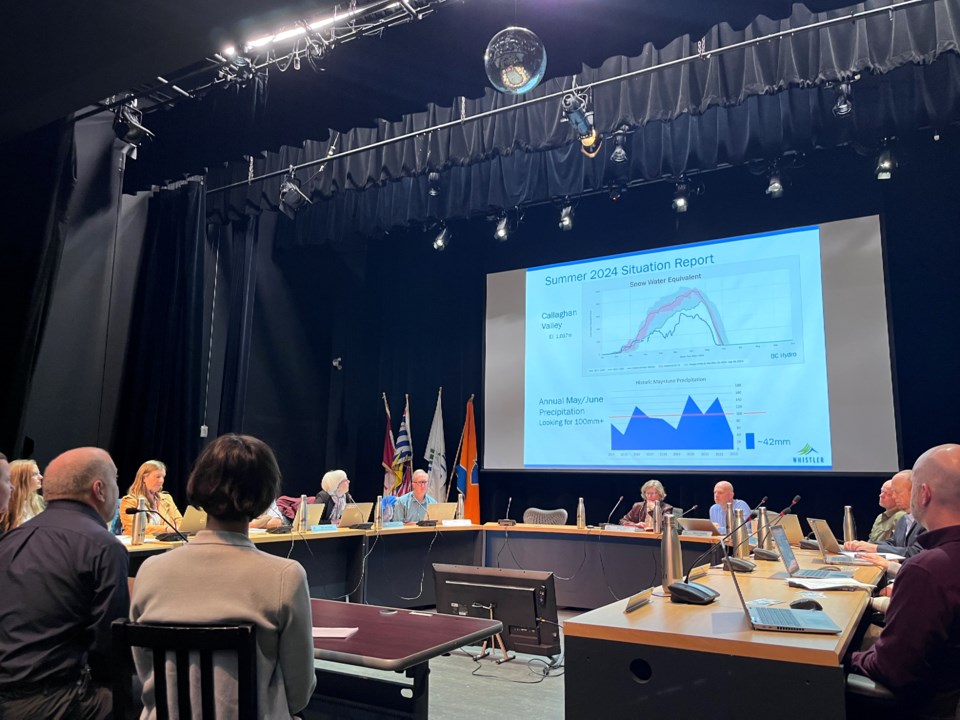Recent rainfall in Whistler is welcome, but officials are still predicting a drier-than-normal summer in the resort, according to an update to Whistler’s committee of the whole on May 28.
In a presentation from eight different speakers from the Resort Municipality of Whistler (RMOW) and Whistler Fire Rescue Service (WFRS), staff reported a high-level view of the state of the province, risks to Whistler, and work to mitigate that risk.
The RMOW’s emergency program coordinator, Bob Manson, reported the area is much drier than normal, pointing to the province’s Snow Survey and Water Supply Bulletin for May 15.
“In looking at that you’ll see this province as a whole is very dry,” he said.
The South Coast region, which encompasses Whistler, is currently rated as 45 per cent of normal, and dropping quickly. The most recent report from May 15 is 16 points below the previous measurement taken May 1, when the region was at 61 per cent of normal.
The province as a whole was rated as 57 per cent of normal as of May 15, down from 66 per cent of normal on May 1.
Manson said at this time in 2023, the South Coast region was at 52 per cent of normal, making 2024 even drier—meaning the summer ahead will likely be dry.
“The outlook at this point is it will be a dry summer and potentially a very hot one,” he said.
Manson also spoke about the lack of snowpack and the ongoing rain as of May 28.
The most recent measurements for Whistler were at 42 millimetres for the month of May—and going by BC Wildfire, the precipitation received in May and June goes a long way to inform how the fire season pans out.
“For us to have a lower level of risk for a fire season, we’re looking at 100 mm of rain or more,” Manson said. “This time last year, for all of May we had 12 mm. This year, we’re currently at 42mm, so if it keeps up the way it is we’ll hopefully get into some good levels of precipitation.”
Manson added the rain will help with wildfire risk, but likely won’t be enough to counteract drought conditions.
“It’s still not going to remove all of the risk, but it’s certainly going to make it a little easier for us in terms of fire conditions if it continues on the way it is,” he said.
A caveat, he added, is that so far the rain this May has been small amounts spread over an entire day, “and that kind of rain just evaporates,” and doesn’t soak into the soil.
All in all, Manson reported conditions were slightly better than 2023 given the alternative.
On vegetation management, the RMOWs manager of climate and the environment Luisa Burhenne reported the municipality is focused on Emerald West, along Highway 99 and the Brio area for 2024.
She also gave a high-level update on studies into forest-thinning and monitoring, saying RMOW staff “want to make sure there’s no unwanted side effects to our work,” noting so far treated areas are showing reduced wildfire potential.
The committee also received some updated numbers on ongoing FireSmart initiatives, with the RMOW’s lead hand on the program, Jesse Lieberthal, reporting increased uptake in 2024 with 66 registrations so far.
Also speaking were members of the WFRS, which continues to lean into community engagement and education, and upgrades to their facilities and equipment to better prepare the resort for wildfire season. Notably, WFRS officials reported increased training and preparation for wildfire fighting alongside structure-fire training, with fire trucks fitted out with more equipment, and personal gear for fire fighters being brought up to wildfire fighting grade.
The WFRS also talked about training and cooperation with BC Wildfire.
WFRS fire chief Thomas Doherty previously spoke with Pique about efforts on behalf of the WFRS to get the message out and make Whistler as a community more resilient.
A big development for WFRS is Fire Hall No. 3 on Spring Creek Drive will be fully staffed and operational from June 11. The RMOW previously reported it was increasing funding to the WFRS to hire additional personnel to achieve staffing at that hall in February, in addition to its fully-staffed Fire Hall No. 1.
Overall, staff summarized that wildfire continues to represent the greatest climate-change related risk to Whistler, and is the community’s greatest vulnerability, hence the staff time and investment put into resilience.
Councillors asked a handful of clarifying questions, and all made comments on the cooperation between various departments and higher provincial agencies on the file.
“I’m encouraged by the fact there is increasing partnership with the BC Wildfire Service,” said Mayor Jack Crompton.
Councillors voted to receive the report. The entire presentation can be watched on the RMOW website.




